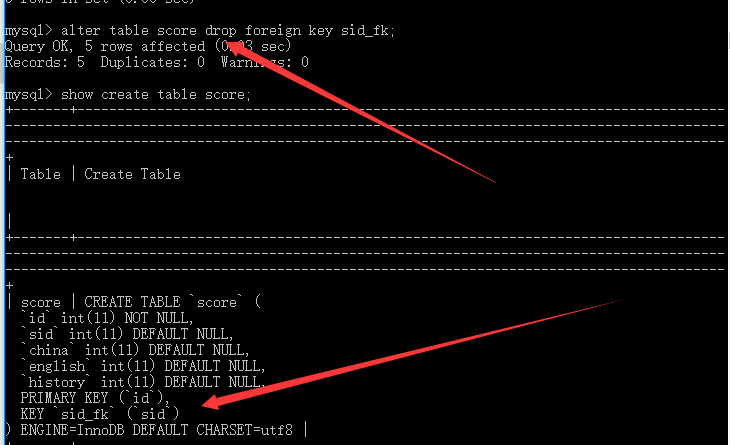前记
最近一直在学习后台,学习到了数据库,记录mysql中的常用语句,以便自己日后反查,如果还想更多的了解可以去官网,这是非常详细的中文官方文档。
自己在mysql 客户端实际操作了一遍,另外画了脑图,方便自己记忆和复习。
1,使用MySQL,需要下载MySQL客户端,具体操作自行百度即可。
记录自己当初犯下的错误,通过doc命令进入mysql :
- mysql -u root -p(记住千万不要输';')
出现此界面说明成功登陆mysql 客户端
以下是常用sql语句:
一,关于数据库
1,创建数据库
create database mydb ;
2,查看创建数据库语句(查看mysql创建的源码)
show create database mydb ;
3,使用数据库(需要先调用此语句,才进行其他操作)
use mydb (可写可不写分号)
4,删除数据库
drop database mydb ;
5,查看所有的数据库
show databases ;
6,修改数据库mydb1的字符集为utf8
alter database mydb1 character set utf8 ;
7,了解
创建数据库mydb1,字符集用gbk
create database mydb1 character set gbk ;
查看数据库中所有的校对规则
show collation ;
查看中文的校验规则
show collation like '%gb%' ;
创建数据库mydb2,字符集用gbk,校验规则用gbk_bin
create database mydb2 character set gbk collate gbk_bin ;
设置客户端的字符集为gbk
set character_set_client=gbk;
设置结果集的字符集为gbk
set character_set_results=gbk ;
二,关于表
1,创建表t
create table t(
id int ,
name varchar(30)
) ;
创建表t1,使用字符集gbk
create table t1(
id int ,
name varchar(30)
)character set gbk ;
自动增长
create table t2
(
id int primary key auto_increment,
name varchar(20)
) ;
2,查看创建表的源码
show create table t ;
3,插入数据
insert into t(id,name) values(1,'张无忌') ;
insert t(id,name) values(2,'乔峰') ;
省略字段,意味着所有的字段都必须给值(自增例外)
insert t4 values(3,'杨过','2014-4-3') ;
4,更新
将表t4的第三条记录姓名字段改为杨康
update t4 set name='杨康' where id = 3 ;
将所有记录的名字都改为东方不败
update t4 set name = '东方不败' ;
修改多个字段
update t4 set id=6,name='萧峰' where id = 2 ;
5,删除
删除表格
drop table t4;
删除所有的记录
delete from t4 where id = 4 ;
delete from t4 ;
truncate table t4 ;
6,字段处理
给表t4增加一个字段address
alter table t4 add address varchar(100) ;
删除字段address
alter table t4 drop column address ;
7,查看表的结构
desc t4 ;
三,DQL:数据查询语言
创建一个学生表
create table stu
(
id int primary key, #主键约束
name varchar(30) unique, #唯一约束
sex char(2) not null, #非空约束
age int ,
address varchar(50) default '北京' #默认约束
) ;
insert into stu values(1,'张无忌','男',20,'北京') ;
insert into stu values(2,'小龙女','女',18,'古墓') ;
insert into stu values(3,'黄蓉','女',15,'桃花岛') ;
insert into stu values(4,'韦小宝','男',24,'扬州') ;
insert into stu values(5,'乔峰','男',34,'雁门关') ;
insert into stu values(6,'张果老','男',30,'雁门关') ;
insert into stu values(7,'老张','男',38,'黒木崖') ;
insert into stu values(8,'张','男',34,'桃花岛') ;
insert into stu values(9,'韦小宝','女',24,'新东方') ;
insert into stu(id,name,sex,age) values(10,'令狐冲','男',27) ;
1,查看所有数据
select * from stu ;
2,查看小龙女的信息
select * from stu where id = 2 ;
select * from stu where name='小龙女' ;
3,查看年龄在20~30之间的人
select * from stu where age >=20 and age <=30 ;
select * from stu where age between 20 and 30 ; # 包括20和30
4,查看所有的的姓名
select name from stu ;
查看所有的的姓名,年龄,性别
select name,age,sex from stu ;
5,模糊查询
# % 表示任意字符数
# _ 表示任意的一个字符
select * from 表名 where 字段名 like 字段表达式
#查询所有以张开头的人
select * from stu where name like '张%' ;
#查询姓名中含有张这个字的人
select * from stu where name like '%张%' ;
#查询姓名中含有张这个字的人并且姓名的长度是3个字的人
select * from stu where name like '张__' or name like '_张_' or name like '__张' ;
6,distinct
查询表中有几种性别
select distinct sex from stu ;
查找姓名和性别整体都不同的记录
select distinct name,sex from stu ;
创建分数表
create table score
(
id int primary key,
sid int ,
china int,
english int ,
history int,
constraint sid_fk foreign key(sid) references stu(id)
) ;
insert into score values(1,1,68,54,81) ;
insert into score values(2,3,89,98,90) ;
insert into score values(3,4,25,60,38) ;
insert into score values(4,6,70,75,59) ;
insert into score values(5,8,60,65,80) ;
1, 建带有外键的表(即score是stu的子表),需要要添加此语句
constraint sid_fk foreign key(sid) references stu(id)
2, 给字段起别名
select id as 编号,china as 语文,english as 英语,history as 历史 from score ;
select id 编号,china 语文,english 英语,history 历史 from score ;
3, 字段可以有表达式
select id,china+10,english,history from score ;
查看所有人考试的总分是多少
select id,china + english + history 总分 from score ;
查看总分大于200的人
select * from score where china + english + history > 200 ;
3, or 和 in 字段查询
//查询或
select * from stu where address = '桃花岛' or address = '黒木崖' ;
//查询包含
select * from stu where address in('桃花岛','黒木崖') ;
4, not int 字段查询以及语句嵌套查询
select id ,name from stu where id not in(select sid from score) ;
5, null 字段查询
select * from stu where address = null ; #错误的
select * from stu where address is null ;
#查询有地址的人
select * from stu where address is not null ;
五 排序(order by )
1, 升序排列
select * from score order by china asc;
2, 降序排列
select * from score order by history desc;
3, 多个字段进行排序(语文升序,对语文成绩一样的人再进行历史降序类排)
select * from score order by china asc,history desc;(优先前面的查询)
根据考试总分降序进行排序
select *,china + english + history 总分 from score order by china + english + history desc ;
四,约束
1,外键约束
可以理解为一个特殊的字段
创建引用约束
alter table score add constraint stu_score_fk foreign key(sid) references stu(id) ;
删除约束
alter table score drop foreign key stu_score_fk ;
2,引用约束
注意:
1. 添加记录时必须先添加主表中的记录,再添加字表中的记录
2. 不能更改主表中具有外键约束的记录的主键
3. 删除记录的时候不允许删除具有外键关系的主表中的记录
(删除的顺序应当是先删除字表中的记录,然后删除主表中的记录)
六,多表查询
1,交叉查询
(cross join ... on ...)查询每个人的考试成绩
select * from stu s cross join score c on s.id = c.sid ; #交叉 比较了45次
(inner join ... on ...)查询参加考试的人的成绩
select name,china,english,history,china+english+history 总分
from stu s inner join score c on s.id = c.sid ;
(left join ...on...,以左表为主的查询)查询所有人的成绩
select name,china,english,history,china+english+history 总分
from stu s left out join score c on s.id = c.sid ;
(not int)查询没有参加考试的人
select * from stu where id not in(select sid from score) ;
查询参加考试的人的成绩
select name,china,english,history,china+english+history 总分
from stu s,score c where s.id = c.sid ;
2,聚合函数
-
sum max,min avg ,count
//stu表中最大年龄最大的 select max(age) from stu; //score表中china的平均值 select avg(china) from score;
3,分组函数(group by)
select count(*) 数量,sex,name from stu group by sex,name ; #根据多个字段进行分组
//分组条件 group by ...having ...
select count(*),sex from stu where age >=16 group by sex having count(*) >1 ;




